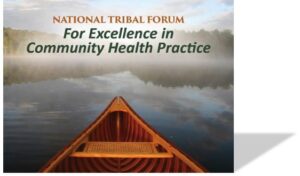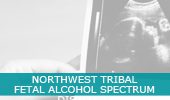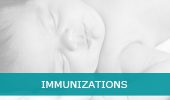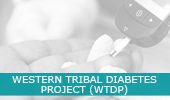Bridget Canniff, Public Health Improvement & Training Program Director
Kimberly Calloway, DVM, Project Specialist, Public Health Improvement & Training
Program Overview:
The NPAIHB was one of 8 tribal grantees to be chosen to participate in the Centers for Disease Control and Prevention’s (CDC’s) National Public Health Improvement Initiative program, aimed at systematically increasing performance management capacity and improving the ability to meet national public health standards. The NPAIHB will be facilitating education and technical support to increase the organizational capacity and Quality Improvement (QI) efforts of its 43 member tribes, while also promoting the integration of a “QI culture” and linking QI with public health accreditation of tribally-based health departments.
Program Goal:
Systematically increase the performance management capacity of tribal health departments and programs serving the 43 federally-recognized Northwest tribes, in order to ensure that tribal public health goals are effectively and efficiently met.
Program Objectives:
- Establish and implement a Public Health Accreditation Performance Management Office that will provide education, technical assistance, and support to tribally-based health departments and programs, to engage in continuous performance improvement using the Public Health Accreditation standards.
- Increase the number of tribally-based health program staff trained in performance management across key areas using Quality Improvement (QI) methods, by facilitating their participation in available trainings and webinars.
Oregon Public Health Modernization Program
Program Manager: Barbara Gladue, Little Shell and Turtle Mountain Bands of Chippewa Indians
Program Analyst: Melino Gianotti
Kick Off Meeting: July 9, 2020 Video Recording
The Northwest Tribal Epidemiology Center (NWTEC), at the Northwest Portland Area Indian Health Board (NPAIHB), will work in partnership with the Tribal Foundation Public Health Services (TFPHS) technical workgroup to address unmet foundational public health services for the 29 federally-recognized tribes in Washington. The goal of the work will be to improve the quality of life for American Indian/Alaska Native people served by tribal clinics in Washington with a focus on communicable disease.
Program Manager: Nancy Bennett, MBA
Program Communicable Disease Epidemiologist: Ashley Hoover, MPH
Communicable Disease Data Briefs:
Tuberculosis HIV Sexually Transmitted Infections Hepatitis B & C
Data Partners Meeting 2/3/21
Presentations:
Epicenter WTPHI overview – Victoria Warren Mears & Nancy Bennett, NPAIHB
Data Linkage – Sujata Joshi, NPAIHB
Data Briefs – Ashley Hoover, NPAIHB
ECHO – Megan Woodbury, NPAIHB
AIHC – Lou Schmitz, AIHC
Next Steps – Wrap up – Nancy Bennett & Ashley Hoover, NPAIHB

The National Tribal Forum for Excellence in Community Health Practice is a gathering that celebrates indigenous achievements and innovations in creating healthier communities. Honoring diversity and unique pathways to wellness, this event is an opportunity for leaders and professionals working in tribal and urban communities to continue to develop a network focused on one common goal: healthy Native communities.
FORUM GOALS
This forum supports excellence in community health practice by:
- Building a national community of practice in Tribal public health.
- Reaffirming the value of tribally-driven approaches to improving health.
- Honoring the diversity of Tribes and pathways to community wellness.
- Sharing stories about successes and challenges in community health practice.
- Exploring the benefits of Tribal public health accreditation and quality improvement.
FOUR FORUM STREAMS
This forum will address four key themes:
- Public Health Accreditation Readiness
- Excellence in Community Health Practice
- Governance and Innovation for Health
- Indigenous Pathways to Health
FORUM PLANNING COMMITTEE
Northwest Portland Area Indian Health Board:
Luella Azule, Nancy Bennett, and Bridget Canniff
Aleena M. Kawe, Russell King, Keisha Musonda, and Krystin Poitra
The Forum Planning Committee appreciates the input of the TARGET Project partner community and public health departments: Cherokee Nation, Chickasaw Nation, Ho-Chunk Nation, and Lac du Flambeau Band of Lake Superior Chippewa Indians. We extend a special thanks to the Kalispel Tribe of Indians and Northern Quest Resort and Casino for hosting this important gathering. We’d also like to acknowledge the Robert Wood Johnson Foundation for providing support for this forum.
National Tribal Forum August 30 & 31, 2016
PLENARY SESSIONS
Stronger Together: Public Health Leadership Opportunities in Indian Country
- Lisa Pivec, MS (Cherokee), Director of Community Health Promotion, Cherokee Nation
Tribes and PHAB: Collaborating for Good Accreditation Outcomes
- Kaye Bender, PhD, RN, FAAN, President and CEO, Public Health Accreditation Board
A 20-Year Retrospective on Tribal Epidemiology Centers
- Victoria Warren-Mears, PhD, RDN, FAND, Director, Northwest Tribal Epidemiology Center, Northwest Portland Area Indian Health Board
- Kate Grismala, MS, Tribal Health Program Support Assistant Director, United South and Eastern Tribes, Inc.
NCUIH 2020: A Collective Demonstration of Exemplary Urban Indian Health Organizations (UIHOs) in Indian Country
- Maurice “Mo” Smith, MA (Navajo), Executive Director, National Council of Urban Indian Health
Public Health Accreditation Readiness
A Tale of Two Tribes: Our Experiences in Community Health Assessment
- Miranda Willis, BS (Chickasaw), Chickasaw Nation
- Bobby Saunkeah, RN, MSHEE, CIP (Kiowa), Chickasaw Nation
- Dave Poupart, Jr., RN (Lac du Flambeau), Lac du Flambeau Band of Lake Superior Chippewa Indians
- Sandra Supinski, REHS, Lac du Flambeau Band of Lake Superior Chippewa Indians
Organizing for Quality: Wisconsin Tribes Working Together to Build Strong Public Health Services
- Lorrie Shepard, RN, Forest County Potawatomi Community
- Nancy Young, MPA, Institute for Wisconsin’s Health, Inc.
Destination Accreditation! Two Tribes Share Their Journey on the Road Less Traveled
- Pam Thunder, BS, Ho Chunk Nation
- Julie Deerinwater-Anderson, MPH (Cherokee), Cherokee Nation Health Services
- Shane Dominick, BS (Choctaw), Cherokee Nation Health Services
Strategic Planning to Achieve Health Equity in Tribal Communities
- Jamie Ishcomer, MPH, MSW, (Choctaw), National Indian Health Board
- Karrie Joseph, MPH, CHES, National Indian Health Board
Excellence in Community Health Practice
Health Impact Assessment: Elevating Public Health Data and Tribal Voices in Decision-making
- Amber Lenhart, MPH, Health Impact Project
- Joseph Kunkel, MArch (Northern Cheyenne), Sustainable Native Communities Collaborative
- Raquelle Myers, JD (Pomo), National Indian Justice Center
Building Our Collective Capacity: The Case for an Indigenous Public Health Institute
- Aleena M. Kawe, MPH (Yoeme), Red Star International, Inc.
- Erin Marziale, MPH, National Network of Public Health Institutes
Implementing the Community of Learning Model for Urban Indian Health
- Kimberly Fowler, PhD, National Council of Urban Indian Health
Quality Improvement in Practice: The Basics and Stories from the Field
- Robin VanDerMoere, MS, ASQ-CQIA, Michigan Public Health Institute, Center for Healthy Communities
Governance and Innovation for Health
Nation Building for Wellness: Tribal Data Sovereignty for Healthy Indigenous Communities
- Stephanie Carroll Rainie, DrPH, MPH (Ahtna Athabascan), Native Nations Institute
- Abigail Echo-Hawk, MA (Pawnee/Athabascan), Washington State University Spokane
Respect and Trust: Keys to Effective Tribal-State Partnerships
- Kristine Rhodes, MPH (Bad River Band of Lake Superior Chippewa), American Indian Cancer Foundation
- Jackie Dionne (Turtle Mountain Chippewa), Minnesota Department of Health
- Darin Prescott, CNP, MBA, RN (Lower Sioux), Lower Sioux Health Care Center
Tribal Public Health and the Law: Challenges and Opportunities
- Aila Hoss, JD, Public Health Law and Policy Consultant
Building Emergency Preparedness Capacity Together: Success Stories from Oregon’s Nine Tribes
- Carey Palm, BS, Oregon Health Authority Public Health Division
- Matthew Lieuallen, JD, Ecology & Environment, Inc.
- Don Courtney, BS (Warm Springs), Confederated Tribes of Warm Springs
- Shana Radford, LLM (Cayuse/Nez Perce), Confederated Tribes of Warm Springs
Indigenous Pathways to Wellness
- Tassy Parker, PhD, RN (Seneca), Center for Native American Health, University of New Mexico Health Sciences Center
- Eric Hardy, BA (Diné), Inter Tribal Council of Arizona
- Madison Fulton, MS (Diné), Inter Tribal Council of Arizona
A Native Approach to Reviving and Maintaining Traditional Tobacco
- Eldon Kalemsa Jr. (Hopi), Hopi Tobacco Program
Childhood Obesity Prevention: An Indigenous evaluation approach
Trainings
What is Public Health Accreditation?
- David Stone, MS, CPLP, Public Health Accreditation Board
A Deeper Look at Public Health Accreditation
- David Stone, Education Specialist, Public Health Accreditation Board
Beyond Accreditation: Using Data to Improve Community Health
- Sujata Joshi, MSPH, Northwest Portland Area Indian Health Board
- Nanette Star Yandell, MPH, Northwest Portland Area Indian Health Board
National Library of Medicine: Community Health Maps
- John Scott, MS (Tlingit), Center for Public Service Communications
- Kurt Menke, GISP, Bird’s Eye View
Quality Improvement in Public Health: Beginning your QI Journey
- Robin VanDerMoere, MS, ASQ-CQIA, Michigan Public Health Institute, Center for Health Communities
- Nancy Young, MPA, Executive Director, Institute for Wisconsin’s Health, Inc.
National Indian Health Board (NIHB):
- Accreditation is a process that will improve and protect the health of tribes by advancing the quality of public health services with improved coordination and potential for increased resources.
- Benefits to tribal members may include a positive impact to current and future health, longer life expectancy, cultural preservation, and improved quality of life.
Centers for Disease Control and Prevention (CDC):
- Public Health system, policy, performance management, and workforce development and/or redevelopment.
- Efficient and effective use of time and resources across and within key areas via standardization, improved networking, best practice implementation, and cross-jurisdictional coordination and cooperation.
- Sustainable QI via accreditation.
- Creation of a national network; improved staff and resource distribution.
- Greater accountability and enhanced credibility to stakeholders, partners, and communities.
Public Health Accreditation Board (PHAB):
- Improve and protect the health of tribes by advancing quality of Public Health services.
- Performance Management and QI; valuable, measurable feedback on strengths and areas of improvement.
- Encourage partnerships between Public Health practitioners, stakeholders and community members.
- Reduce health disparities; same level of Public Health services available to all.
- Recognition of excellence, clarification of expectations, and increased visibility and responsibility.
There are 3 prerequisites that need to be completed before applying for Public Health Accreditation: Community Health Assessment (CHA), Community Health Improvement Plan (CHIP), and the Strategic Plan. All of these are dependent upon the collection and analysis of health status data. It is also important to perform a self-assessment to determine at what level the tribal health department is providing the 10 Essential Public Health Services, as well as readiness for accreditation.
Prerequisites Defined:
- Community Health Assessment (CHA): A community health assessment, in which a Health Department assesses the health needs in the community, the health status of the community and plans its services through the second document.
- Community Health Improvement Plan (CHIP): A community health improvement plan, which maps out exactly what a Health Department is going to do as it works with partners to improve the health status of its jurisdiction.
- Strategic Plan: A strategic plan for the health department, which indicates a Health Department’s service priorities and how it plans to accomplish its strategic goals.
Benefits of CHAs & CHIPs:
- Increases visibility of public health services.
- Creates advocates for public health services.
- Creates a healthy community and better quality of life.
- Anticipates and manages change more effectively.
- Creates a stronger public health infrastructure.
- Builds stronger partnerships within the community.
- Builds public health leadership within the community.
MAPP tool: Mobilizing for Action through Planning and Partnerships (MAPP) is a community-driven, strategic planning process for improving community health. It is facilitated by public health leaders. This framework helps communities to apply strategic thinking to prioritize public health issues and identify resources to address them. MAPP is not an agency-focused assessment process; rather, it is an interactive process that can improve the efficiency, effectiveness, and ultimately the performance of local public health systems. Completing the MAPP process will give you the Community Health Assessment and Community Health Improvement Plan, and also help inform your Strategic Plan.
NPHPSP tool: The National Public Health Performance Standards Program is a National Partnership initiative that has developed National Public Health Performance Standards for state and local public health systems, and also for public health governing bodies.
- Provides performance standards for public health systems and encourages their widespread use.
- Encourages and leverages national, state, and local partnerships to build a stronger foundation for public health preparedness.
- Promotes continuous quality improvement of public health systems.
- Strengthens the science-base for public health practice improvement.
- NPHPSP will give you capacity or assessment of the system, help inform the Community Health Assessment, Community Health Improvement Plan and Strategic Plan, and is one of the 4 MAPP assessments.
- Assesses readiness: purpose and benefits, resources, strategic fit, leadership.
How does PHAB differ from JCAHO and AAAHC accreditation?
All three types of accreditation aim to promote quality of services and performance, based on a national set of standards; where they differ are the types of entities that are eligible to apply for accreditation and the types of services that the standards are designed to improve. Each accrediting body is a unique entity that has different policies, procedures, standards, methodology for revising its standards, length of awarding accreditation, etc. A little about the three organizations is listed below for a quick comparison.
- Joint Commission on Accreditation of Healthcare Organizations (JCAHO): an independent, not-for-profit organization that accredits health care organizations and programs in the United States. JCAHO currently accredits over 19,000 health care organizations. Over the years, the Joint Commission transitioned from accrediting hospitals only to an organization that accredits a variety of healthcare organizations, including ambulatory care, home care, hospice care, and laboratories in hospitals. Learn more about JCAHO at their website.
- The Accreditation Association for Ambulatory Health Care (AAAHC): a private, non-profit organization that accredits organizations that promotes patient safety and quality, and value for ambulatory health care. AAAHC currently accredits almost 5,000 organizations that provide services in the ambulatory health care setting. The types of organizations that become accredited include ambulatory and surgery centers, community health centers, medical and dental group practices, medical homes, and managed care organizations, as well as tribal and student health centers. They are also the official accrediting organization for the US Air Force and the US Coast Guard. Learn more about AAAHC at their website.
- The Public Health Accreditation Board (PHAB): a national non-profit organization that awards accreditation to tribal, state, local, and territorial health departments. Currently, there are no nationally accredited governmental public health departments because PHAB’s accreditation program will launch in fall 2011. The goal of national public health accreditation is to improve and protect the public’s health by advancing the quality and performance of public health departments. Learn more about PHAB at their website.
My health department wants to apply for accreditation, what are the next steps?
- Appoint an Accreditation Coordinator and department-wide team for review of the process, standards, measures, and documentation guidance, as well as the identification of documents.
- Review PHAB’s Online Orientation to Public Health Department Accreditation. While this review is required for the Accreditation Coordinator and the health department director, it contains great information that health departments can share with their staff, boards of health, elected officials, and community partners as they prepare for accreditation.
- Review the documentation requirements for the measures and note the areas where the health department needs to be sure that documentation potentially used in accreditation is “up to speed”. That means dating agendas, communications, and policies as they are developed; signing and dating contracts; keeping sign-in sheets for various trainings; and creating an electronic filing system to store information so that it can be easily found for future reference.
- Begin/refine work on the prerequisites. Completing these prerequisites lays wonderful groundwork for identifying the documentation for meeting the rest of the measures. So, getting these done properly will get a health department off to a good start. Remember to contact Rachel Ford at rford@npaihb.org for technical assistance.
- Prepare documentation according to the guidance contained in the PHAB Standards and Measures Version 1.0.
I understand that the IRS will require hospitals to develop a Community Health Assessment. Should my health department seek to collaborate with the local hospital to develop one assessment that addresses both the health department’s and the hospital’s Community Health Assessment needs?
PHAB strongly encourages health departments to develop partnerships with hospitals and other community members in order to collaborate on a variety of efforts, as indicated throughout the PHAB standards and measures. Hospitals are critical partners and can contribute primary and secondary data, planning expertise, community meeting facilities, as well as community health education and health promotion programs and services.
The IRS requirement that non-profit hospitals report on the development of a Community Health Assessment provides a perfect opportunity for your health department to initiate or further develop your partnership with local non-profit hospitals. Collaboration on the development of a Community Health Assessment that addresses both of your information needs can be one element of your partnership. PHAB encourages you to review the IRS reporting form for hospitals (Schedule H, Form 990, OMB No. 1545-0047). Part V, Section B, sets forth the details that are to be reported including the hospital’s process for consultation with others who represent the community’s interest, the process for identifying and prioritizing health needs, and how the hospital addressed those identified health needs. In addition to the Community Health Assessment, non-profit hospitals are required to report their “community benefit” and “community building” activities, including coalition building and community health improvement advocacy. All of these IRS requirements provide an excellent opportunity and incentive for health departments and non-profit hospitals to work together to improve health of the population for the benefit of the community. For more information, please visit this IRS website.














